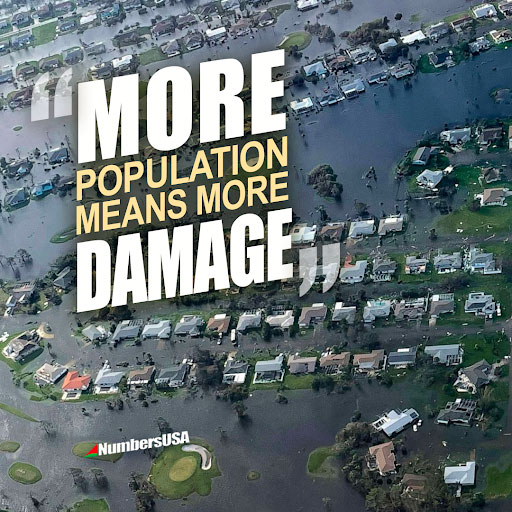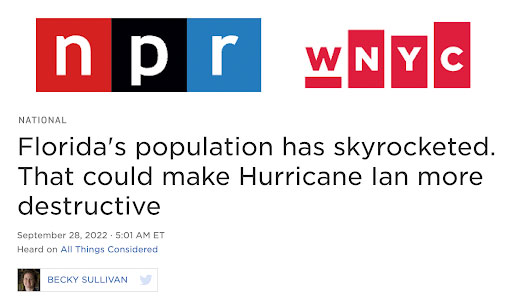
Hurricane Ian will likely go down as the most expensive storm in Florida history: $66 billion in property damage and a record number of homes and properties destroyed. The damage is still being calculated. By one measure, Ian is tied for the fifth strongest storm to hit the United States.
The population boom in hurricane-prone Florida is an example of the “expanding bullseye effect,” said Stephen Strader, a professor at Villanova University who studies how human environments are vulnerable to natural disasters.

Becky Sullivan of NPR speaks with Strader, and comes to a simple conclusion:

“There are more people than ever before in the path of these storms,” Strader tells The Washington Post. “We really haven’t done much to check this growth … What we are finding out is that is not sustainable.“
According to our own studies of government data:
— Only Texas has built over more open space than Florida over the last 35 years for which data is available;
— Florida has more total developed land than any other state outside of Texas and California;
— Almost all of Florida’s recent sprawl is due to population growth.

Floridians are living more densely than ever before, but 10.5 million more people lived in the Sunshine state in 2017 than did in 1982. All of that growth has expanded the “bull’s eye” for storms like Ian to wreak havoc.
Leon Kolankiewicz, the lead author of NumbersUSA’s study, says:
Florida’s explosive population growth in recent decades, especially along its crowded coastlines, has put more people and their homes than ever in harm’s way. And this population and coastal development boom shows no sign of abating, rising seas and more destructive hurricanes notwithstanding.”
Federal immigration policy was responsible for two-thirds of Florida’s population growth from 2000-2010 (the data for the decade ending in 2020 is scheduled for release in December). Congress’s immigration policies are the sole long-term determinant of national population growth.
“I first went to Miami in 1964 when its population was just over 1.6 million,” writes the Naturalist Karen Shragg. “It is now still growing at over 6 million. Water is already threatening the water supply of Dade County. The intrusion of saltwater into their shallow aquifers began when the Everglades were drained to provide dry land for development, another human created disaster by our addiction to growth.”
The Resilient Cities Catalyst group says “Cities and urban communities too often avoid their long-term risk exposures and underlying stresses. Doing so often results in fundamental disruption to their work for change.” The same can be said for Congress. Immigration-driven population growth is often touted as a shortcut to “economic growth,” but policy makers rarely consider the medium-or-long-term effects of their policies. Immigration at this scale isn’t so much a shortcut as it is short-sighted.
JEREMY BECK is a V.P., Deputy Director for NumbersUSA